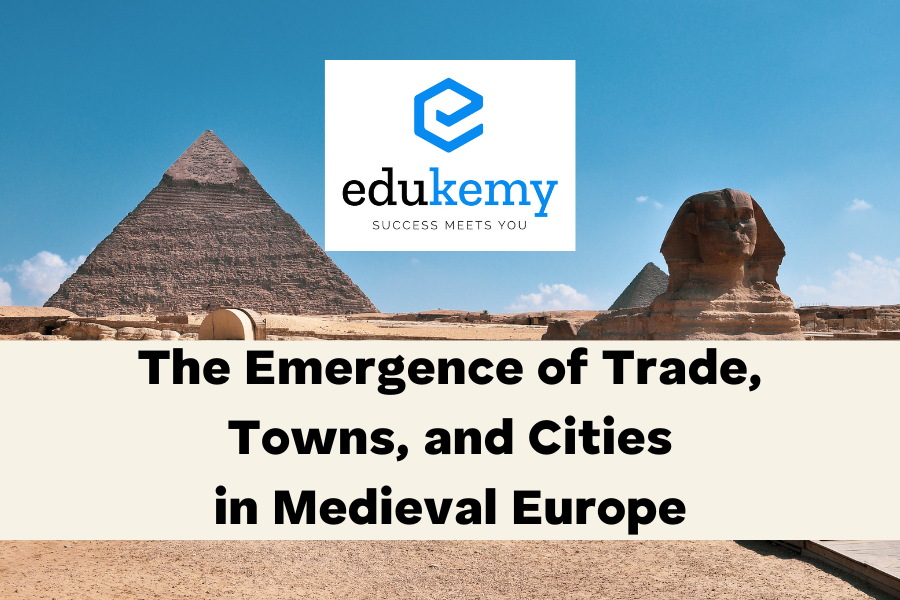
The rise of trade, towns, and cities in medieval Europe was a significant development that transformed the economic and social landscape. Several key factors contributed to this transformation:
- Contact with the Arabs during the Crusades:
- In the 7th century, the Crusades brought Europe into contact with the Arab world, exposing Europeans to the rich and advanced Arab civilizations. This contact increased the demand for luxury goods from the East among European lords.
- Agricultural Productivity and Peasant Buyers:
- Advances in agricultural methods led to increased productivity, allowing peasants to have more surplus income. As a result, they became buyers of non-agricultural goods, further stimulating trade.
- Rise of Crafts and Towns:
- The increased demand for goods gave rise to crafts and artisanal production. Towns where these crafts were produced became increasingly important.
- Emergence of Towns and Cities:
- The 11th century marked a period of rapid urbanization, with towns growing into cities. Peasants gradually transitioned into artisans, and merchants began to settle in these growing towns.
- Development of Trade Routes:
- Towns and cities developed along both land-based trade routes and sea ports. Ports played a crucial role in importing goods from Asia, which were then transported along overland routes to mainland Europe.
- Italian City Development:
- Italy, with its favourable geographical location and natural harbours, witnessed significant city development. Sea-port cities like Venice and Genoa became prominent trading hubs due to their strategic locations and ease of trade with the East.
- Continued Prosperity:
- The seaports and inland trade centres that developed during this period continue to be thriving cities in modern Europe, reflecting the enduring impact of this medieval transformation.
The emergence of trade, towns, and cities in medieval Europe not only boosted economic activity but also led to social and cultural changes. These urban centres became hubs of commerce, culture, and innovation, contributing to the development of the modern European landscape.
Contents
- 1 FAQs
- 1.1 1. What factors contributed to the emergence of trade in Medieval Europe?
- 1.2 2. How did towns evolve in Medieval Europe?
- 1.3 3. What role did guilds play in Medieval European towns?
- 1.4 4. How did the rise of cities impact Medieval European society?
- 1.5 5. What were some key trade routes in Medieval Europe?
- 2 In case you still have your doubts, contact us on 9811333901.
FAQs
1. What factors contributed to the emergence of trade in Medieval Europe?
Answer: Trade in Medieval Europe was spurred by various factors, including the revival of long-distance trade routes such as the Silk Road, the Crusades opening up trade with the Middle East, and the growth of towns as centers of commerce and craftsmanship.
2. How did towns evolve in Medieval Europe?
Answer: Towns in Medieval Europe emerged primarily as centers of trade and commerce. They often began as marketplaces or settlements near castles or monasteries, gradually growing due to increased trade and the influx of artisans and merchants seeking economic opportunities.
3. What role did guilds play in Medieval European towns?
Answer: Guilds played a crucial role in regulating trade and craftsmanship in Medieval European towns. These associations of artisans and merchants set standards for quality, prices, and working conditions, contributing to the development of skilled labor and the protection of members’ interests.
4. How did the rise of cities impact Medieval European society?
Answer: The rise of cities in Medieval Europe brought about significant social and economic changes. Cities became centers of innovation, culture, and learning, fostering the exchange of ideas and the growth of specialized industries. Additionally, the urban lifestyle attracted people from rural areas, leading to demographic shifts and the development of a burgeoning middle class.
5. What were some key trade routes in Medieval Europe?
Answer: Several important trade routes facilitated commerce in Medieval Europe, including the Hanseatic League’s route connecting Northern Europe with the Baltic Sea, the Amber Road stretching from the Baltic to the Mediterranean, and the Silk Road linking Europe with Asia. These routes played a vital role in the exchange of goods, ideas, and culture, contributing to the flourishing of trade and urbanization in the medieval period.
In case you still have your doubts, contact us on 9811333901.
For UPSC Prelims Resources, Click here
For Daily Updates and Study Material:
Join our Telegram Channel – Edukemy for IAS
- 1. Learn through Videos – here
- 2. Be Exam Ready by Practicing Daily MCQs – here
- 3. Daily Newsletter – Get all your Current Affairs Covered – here
- 4. Mains Answer Writing Practice – here

